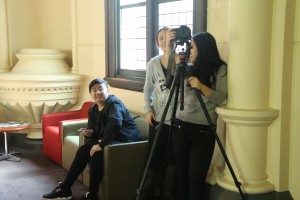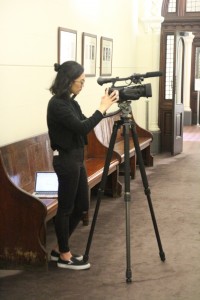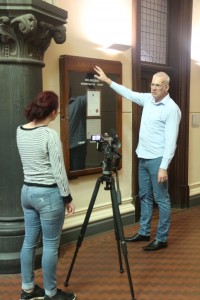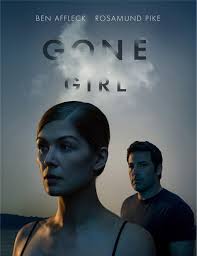The Virtual Tour Set Back
We have another setback. The virtual tour 360 panoramas haven’t turned it as they were meant to be because we only did the 180 degree shot of them. Definitely these minor details or couple of images make a huge difference.
We are thinking of going in on Thursday so I hope it can all work out.
This is an example of one of the 180 Degree panoramas.
Editing: In progress
I am getting to the end of my editing process. I am a little behind schedule as I hope to finish off most of it today and to only have a couple touch ups to do up and till Friday. However I’m a little under the weather and its definitely taking a toll.
I am still thinking of cutting the piece down. The voice over is in a poem style and has a rhythm to it that fits to the mellow music. With the music it was hard to find the right balance because I didn’t want it to be melodramatic or sad or upbeat but somewhere in between. The music from my main inspiration (see below) was definitely a bit more sad than I would want my piece to be but it was a good starting point.
Inserting the photos into the video has given it more texture. Some of the stop motion isn’t perfect and as smooth as the other parts however I do prefer it with some flickering and jagged movements.
I’m not entirely sure how to end it right now, originally I had it to go in reserve down the hallway with the credits rolling. However I have changed the script and need to see if that still works.
There are still some parts of the voice over I might change tomorrow because its not always correlating with whats on the screen.
Getting to the last week of the project I’ve been reflecting more and more on the process. I definitely feel that it was something completely new for me and I’m glad that I tried it. I think my planning stage should have been more thorough though because I felt that I could have threaded more of the themes into the story using motifs, objects, metaphors etc.
Here was my main inspiration:
Sunday Court Day
The Sunday filming day was productive and I got majority of my individual project and with Linh and Cassie completed all the photos for the virtual tour for building 20. (We had a little set back when we realised at about 5pm on Sunday that we forget to do the caretaker sign and then had to go back again to do the panorama shot on Monday as well)
It definitely took longer than I thought. Probably like 2 and half hours of photo snapping but I got probably a solid 2 minutes of footage in (still in the tedious process of editing it).
(Snaps of our class – photo credits to Rachel Wilson)
Historians and Researching
Jumping back a few weeks ago when Abigail Belfrage come into the class to help us individually with our projects was very helpful. She really went above and beyond to try make sure we were hitting every possible avenue for researching which is really great.
Some of the avenues that I have been researching in:
Melbourne Uni Archives
Being searching through political organisations she was involved in and looking at which organisations would be creating information about her.
– Women’s Social and Political Union, Women’s Political Association, Victorian Socialist Party, militant Women’s Peace League
NAA – National Archive
Women’s Political Association – Naturalisation (Documents)
Victorian Socialist Party – reportage documents
Women’s Peace Army (1915 -1916)
– Found records however not of her just of people who were affiliated with her – however this can still be useful as records when talking about the groups she was affiliated with
Women’s petition – document
People who have written extensively about the socialist groups and movements
– Jeff Sparrow, Stuart McIntyre
Prison record – still to follow up on
The Australian women register
ADB – Australian dictionary biography – has a brief biography about her
Criminal Record Office – photos of her under surveillance
– very limited but a great photo

Jennie Baines by Criminal Record Office <http://www.npg.org.uk/collections/search/person/mp58989/jennie-baines>
*To keep in mind that Suffragette was a British term and that Australian documents might not have used this term
Editing Masterclass with Jeremy
Jeremy Bowtell, a former RMIT student conducted an intro to editing on Adobe Premiere. I am familiar with Adobe Premiere and have edited all my media projects using it so far although it was great to get back to the basics to fill in some of those gaps. Even things like what a scratch disk or using Premiere is non-destructive editing meaning it doesn’t change the original at all. Definitely building a strong foundation, learning without the shortcuts I think is the best way for me to learn because later on you can cut out some of them more tedious steps when you have to a higher level. Also, I picked up a few things more someone who has professional editing experience and could add that perspective.
One of the most new aspects that I learned was the very basics of colour grading and white balancing on Premiere. Although we shouldn’t rely on white balancing through Premiere, it can work pretty well if there is something that is pure white in the clip. I think the colour grading can come in handy because I had to go back and shot some photos near the end of the shooting day which were slightly darker because of the lighting.
Introduction: The influence of Place by J.E. Malpas
“The land around us is a reflection, not only of our practical and technological capacities, but also of our culture and society”.
“Our relation to landscape and environment is indeed one of our own affectivity as much as of our ability to effect”. It reflects our news like a dam or a farm for basic neccesities but also through the capacities we have to demolish, construct, build, rebuild, design we also begin to intertwine with the landscape what we want for the environment.
Also our identity is linked to a location or place. In Aboriginal Australian culture this emphasis on a person’s identity to where they were conceived or ancestral history is shown through how the “Land around them them everywhere is filled with marks of individual and ancestral origins and is dense with story and myth”.
Personally, my identity isn’t linked to a particular place or location as I was born in Australia although my culture background comes from China. Thus there is a disconnect between location and identity. My identity is a blend between two different places. But also do I need to live in China to connect to my heritage or there other ways as well? In Australia, there are signifiers of Australian-Chinese culture blending together. There is China Town, Chinese New Year celebration (event rather than location), there are other festivals relating to Chinese culture, even a Chinese museum. Australia being a multi-culturally country it has links to a lot of different cultures in the city.
Production companies to look out for
This is a blog post not related to Ghosts and Space but more to the film industry in general. Last week I stumbled across an article in Variety about the production company Pacific Standard run by Bruna Papandrea and Reese Witherspoon. It is dedicated to the goal of producing and developing film roles for women, especially for women over 30 (where the content starts to be thin). They have already released two films Gone Girl and Wild which have both been critically acclaimed and the audiences have been engaged with. I think it is very exciting to see production companies that are bringing more diversity to the big screen. I share the goal of bringing more diverse voices into the main stream, when there are different people the behind the scenes as well as on the screens then the landscape will shift.
Also, there is also the production company Dollhouse collective, run by 5 Australian actors and filmmakers who are committed to “telling stories with a strong female presence” as said by one of the co-owners Gracie Otto. Also, not just limited to film but also developing content in television and theatre.
Looking forward to what they produce!
Image Source: http://www.literarytraveler.com/books/gone-girl-whats-lost-in-translation-and-does-it-matter/
Lecturer: Paul Gough Lecture
With ANZAC Day just passing on this Saturday and with it being the centenary it was fitting for Paul Gough to talk to us a couple weeks ago about memorialisation.
When a space becomes a place it becomes involved/endowed with human memory. With memorials being related to emptiness as they show and remember what has been gone. Paul made an excellent point that the emptiness in memorials ain’t empty they are layered in absence and emptiness.
A key question we explored was why do we have memorials?
A place to remember the dead, people who have passed
Focal point of grief
Place of ritual
I think also for War memorials there is a notion of “Never again”
I think a telling sign of how fundamental it is that we have memorials is the fact that after WWII they didn’t want hospitals or more functional services they wanted memorials, they wanted a place to grieve, to remember the people who they had lost. Perhaps its part of our need for “closure” and it connects us with humanity, the people who have come before us. It’s a reflection of our history. I think there is this fear of being forgotten, I think we all want to leave our mark on the world and this may be in respect to people who have come before to say that we appreciate you and we will remember you.
Brief #3: Ghosts and Place
Title: Mrs. Baines goes to Court
- Format: Mixed Media, Stop Motion Film, Personal Documentary – Have narrative over the top
- Proposed Length: 1 ½ Minutes to 2 Minutes
Synopsis – what ‘happens’
- The Forgotten: Highlight a story of the magistrate court that has been forgotten, not heard a lot about narrated by myself
- The various perspectives: Main Character is Jennie Baines (Part of the Suffragette Movement in the UK and Melbourne)
Focus on her court case on Tuesday March 18th 1919 (Will reference to her the ones leading up to it as well)
- She was arrested with Richard Long for exhibiting a red flag (International sign for socialism) at the demonstration/ “meeting” in Melbourne. She refused to pay the fine or sign the bond this lead to the first reported prisoner in Australia to go on a hunger strike
- Telling the story from various perspectives (Of her supporters, the media and her family) of the court case of Jennie Baines in 1919
- Personal: Tie it in with my personal opinions of the significance of it and the relation to our social, political situation as of today
Why
Although the aspects of the Catherine and the case that interested me was the perspective of the female thief and criminal. What her intentions were behind it. My original concept was for an actor as Catherine Smith to tell the story and then have the characters, locations superimposed in the screen as well. Visual “Ghosts”
However not just a retelling of the story was what I wanted to show. The second story provided more of a social context and more resources to be mined as well. I found it hard to find court cases and there were the three prominent ones of Ned Kelly, Squizzy Taylor and the Eureka Stockade. Although I did want to tell a story that was less well known. I come across Jennie Baine’s story, as it was part of an online Melbourne Walking Tour. She was reported to be the first person ever to go on a hunger strike in Australia. I think she had a very unique perspective like Catherine Smith on the what was happening at the time.
From the various approaches to space/place we have looked at so far WHICH concept does it most readily relate to?
It relates to place and memory and also what we remember and forget through history. When Professor Paul Gough came to his talk we were talking about the very topical issue of ANZAC day and forgotten soldiers. However I think it was interesting that a couple of days later I was talking to a friend who is a producer for a political radio show on SYN and they wanted to do a piece on the people who were forgotten, like women and indigenous people as well. Using the court room’s physical objects and matching that up with old photography to lead the story and ‘spark’, ‘relive’ the events of the past.
Inspiration
https://www.shortoftheweek.com/2014/06/04/gan-gan/
Stop motion film Gan Gan
The stop motion has that disorientating effect because time is moving so quickly – in the theme of forgotten and memory it has that same feeling of things slipping again
Blight: https://www.youtube.com/watch?v=yil33Hb9BpM
Explored the association between sound and image in a more abstract way
http://www.alfred-hitchcock-films.net/Themes/Double-Exposure-Theme.htm
Double Exposure Shot in The Wrong Man
The scene: https://www.youtube.com/watch?v=WUN5c6jtTvU
Sunrise – the women scene – From 2:27
https://www.youtube.com/watch?v=TyNE3Pfq-KM
Work so Far
Researched into Catherine Smith
– Mainly through Trove and PapersPast looking through old newspapers for clues
Went to the public records office
– Looking at old magistrate registries – although unsuccessful I learnt a lot about the process of it – more about which documents to book
More Research Into Jennie Baines
– Timeline her activity
– Looking at books online regarding the women’s suffrage movement
– Finding photos of her
Looking into Stop Motion equipment and method
– Equipment that I will need to use
Did a test run using my iPhone
Although it will be a different camera I still got a feel of how it might work and saw some problems that might come up
Test Shot #1 (Morning)
Other versions – this was just the best one so far
100 Shots = 20 seconds
Lighting
It’s flickering – Whichever camera I use needs to have auto exposure off to compensate for this
The room was dim – in the afternoon it could be better
All the lighting comes from the top as well which can make the bottom – where all the shots will be quite dark – wood all blending together when you get close up
Do I want to bring in my own lighting? To brighten it up and then colour grade it later
Camera Shake
I was using my iPhone without a tripod so it was shaky
However moving a tripod for a tracking shot might not be able to get the minimal movement needed – I think for the tracking shots I will use a light weight camera on a tripod stick
Although in the final I think a little bit of shakiness or distortion with the tracking shots will add to the effect of it
Focusing
Auto focus off
Timeline
| Week | Activity |
| April
20th – 26th |
Friday: PITCH Saturday – More research – finding key points to highlight in the story Contacting Historians if need be Sunday – Scripting along side the Storyboard – Will I need actors? |
| 27th – 3rd May | Tuesday 28th Already booked to go in: PRO – Research Thursday 30th |
| May
4th – 10th |
Saturday 9th & 10th Filming at the Court |
| 11th – 17th | Thursday 14th
Filming outside shots and other locations Saturday 16th & 17th Filming (Not at the court – other shots that I need) |
| 18th – 24th | Tuesday 19th
Editing/Music Selection Sunday 24th Editing |
| 25th – 31st | Thursday, Sat, Sun Editing |
| June 1st – 7th |
Friday 5th: PROJECT DUE |
| 8th – 14th | Friday 11th: PRESENTATION |
Any aspects you need help with (ie class in using a particular software, access to particular equipment etc)
I will be shooting with a DSLR Canon 60D, some people even use webcams for beginners however I want a better quality
“Canon EOS cameras with live view are probably the best choice for shooting stop motion animation. They have a large, high-quality live view image that can simulate exposure settings. And they don’t seem to suffer from overheating the way some other cameras do.”
Handheld – Canon HV40, Sony HDR-HC7
Tripod
Editing – Adobe Premiere
24 second frame rate
Colour grading




